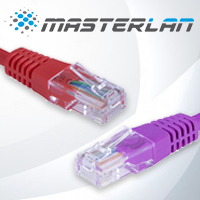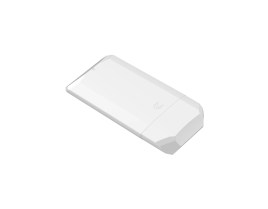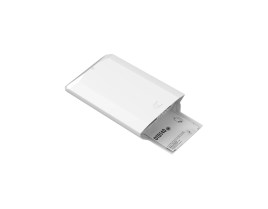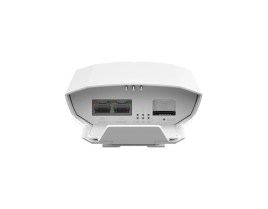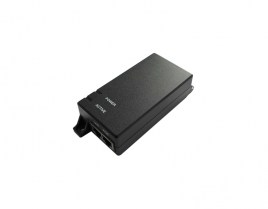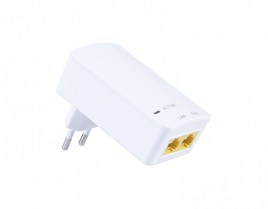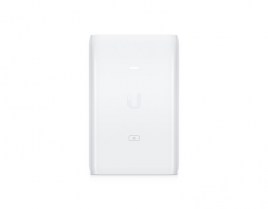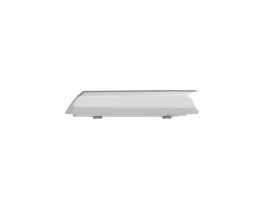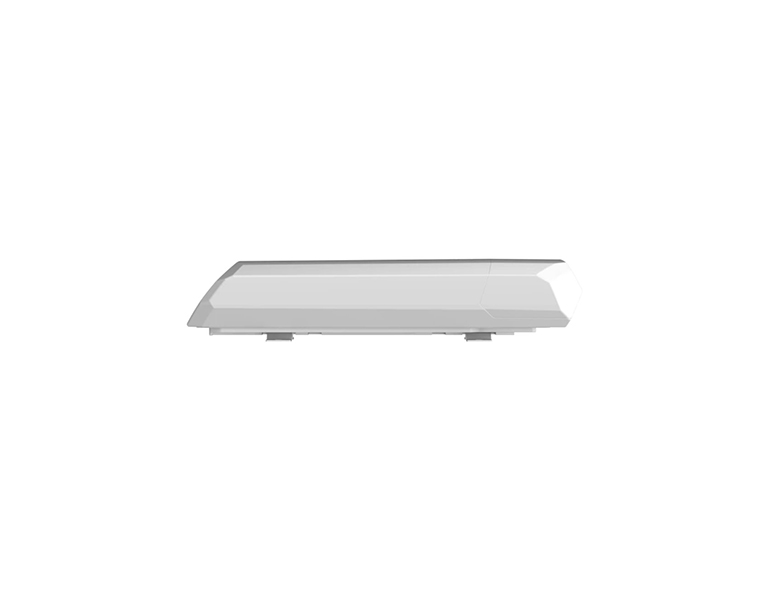
- Description
- Specifications
- Downloads
- Reviews
Teltonika OTD140 Outdoor 4G Router
The OTD140 outdoor router features a dedicated and durable IP55 plastic housing and an integrated mounting bracket, making this outdoor 4G router easy to deploy and capable of withstanding outdoor environmental conditions. Beyond that, this outdoor router is equipped with LTE Cat 4 connectivity, compatibility with RMS for remote management capabilities, and two PoE-in/out Ethernet ports.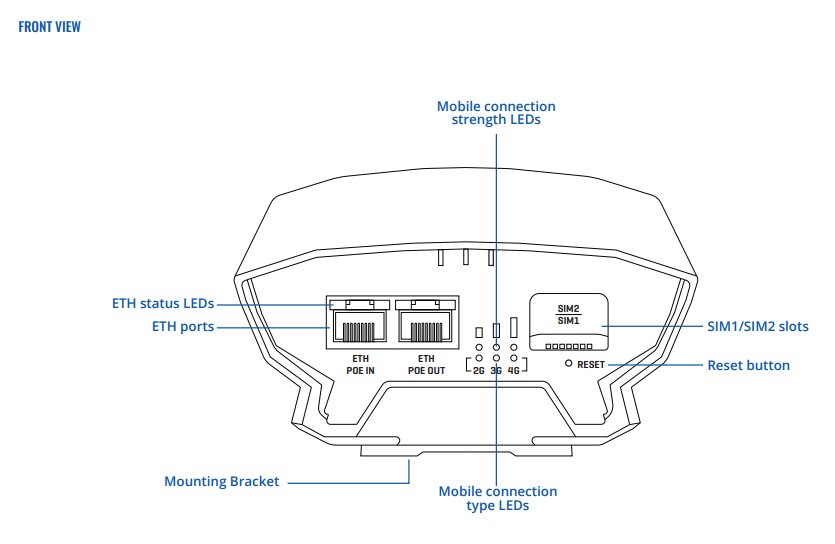
| Warranties - Returns: | |
| Money Return: | Repair - Replacement: |
| 20 days | 24 months |
| Specifications | |
| MOBILE | |
| Mobile module | 4G (LTE) - LTE Cat 4 150 Mbps DL, 50 Mbps UL; 3G - 21 Mbps DL, 5.76 Mbps UL; 2G - 236.8 kbps DL, 236.8 kbps UL |
| SIM switch | 2 SIM cards, auto-switch cases: weak signal, data limit, SMS limit, roaming, no network, network denied, data connection fail, SIM idle protection |
| Status | Signal strength (RSSI), SINR, RSRP, RSRQ, EC/IO, RSCP, Bytes sent/received, connected band, IMSI, ICCID |
| SMS | SMS status, SMS configuration, send/read SMS via HTTP POST/GET, EMAIL to SMS, SMS to EMAIL, SMS to HTTP, SMS to SMS, scheduled SMS, SMS autoreply, SMPP |
| USSD | Supports sending and reading Unstructured Supplementary Service Data messages |
| Black/White list | Operator black/white list |
| Band management | Band lock, Used band status display |
| APN | Auto APN |
| Bridge | Direct connection (bridge) between mobile ISP and device on LAN |
| Passthrough | Router assigns its mobile WAN IP address to another device on LAN |
| ETHERNET | |
| LAN | 2 x ETH ports (can be configured as WAN), 10/100 Mbps, compliance with IEEE 802.3, IEEE 802.3u, 802.3az standards, supports auto MDI/MDIX crossover |
| POE IN | |
| PoE ports | 1 x PoE In |
| PoE standards | 802.3af/at |
| POE OUT | |
| PoE ports | 1 x PoE Out |
| PoE standards | 802.3af and 802.3at Alternative B |
| PoE Max Power per Port (at PSE) | 24 W Max (power supply unit dependent) |
| NETWORK | |
| Routing | Static routing, Dynamic routing (BGP, OSPF v2, RIP v1/v2, EIGRP, NHRP), Policy based routing |
| Network protocols | TCP, UDP, IPv4, IPv6, ICMP, NTP, DNS, HTTP, HTTPS, SFTP, FTP, SMTP, SSL/TLS, ARP, VRRP, PPP, PPPoE, UPNP, SSH, DHCP, Telnet, SMPP, SNMP, MQTT, Wake On Lan (WOL) |
| VoIP passthrough support | H.323 and SIP-alg protocol NAT helpers, allowing proper routing of VoIP packets |
| Connection monitoring | Ping Reboot, Wget Reboot, Periodic Reboot, LCP and ICMP for link inspection |
| Firewall | Port forward, traffic rules, custom rules |
| Firewall status page | View all your Firewall statistics, rules, and rule counters |
| Ports management | View device ports, enable and disable each of them, turn auto-configuration on or off, change their transmission speed, and so on |
| Network topology | Visual representation of your network, showing which devices are connected to which other devices |
| DHCP | Static and dynamic IP allocation, DHCP Relay |
| QoS / Smart Queue Management (SQM) | Traffic priority queuing by source/destination, service, protocol or port, WMM, 802.11e |
| DDNS | Supported >25 service providers, others can be configured manually |
| Network backup | VRRP, Wired options, each of which can be used as an automatic Failover |
| Hotspot | Captive portal (Hotspot), internal/external Radius server, SMS authorization, internal/external landing page, walled garden, user scripts, URL parameters, user groups, individual user or group limitations, user management, 9 default customizable themes and option to upload and download customised hotspot themes |
| SSHFS | Possibility to mount remote file system via SSH protocol |
| SECURITY | |
| Authentication | Pre-shared key, digital certificates, X.509 certificates, TACACS+, Radius, IP & Login attempts block |
| Firewall | Pre-configured firewall rules can be enabled via WebUI, unlimited firewall configuration via CLI; DMZ; NAT; NAT-T |
| Attack prevention | DDOS prevention (SYN flood protection, SSH attack prevention, HTTP/HTTPS attack prevention), port scan prevention (SYN-FIN, SYN-RST, X-mas, NULL flags, FIN scan attacks) |
| VLAN | Port and tag-based VLAN separation |
| Mobile quota control | Mobile data limit, customizable period, start time, warning limit, phone number |
| WEB filter | Blacklist for blocking out unwanted websites, Whitelist for specifying allowed sites only |
| Access control | Flexible access control of SSH, Web interface, CLI and Telnet |
| VPN | |
| OpenVPN | Multiple clients and a server can run simultaneously, 27 encryption methods |
| OpenVPN Encryption | DES-CBC 64, RC2-CBC 128, DES-EDE-CBC 128, DES-EDE3-CBC 192, DESX-CBC 192, BF-CBC 128, RC2-40-CBC 40, CAST5-CBC 128, RC2-64-CBC 64, AES-128-CBC 128, AES-128-CFB 128, AES-128-CFB1 128, AES-128-CFB8 128, AES-128-OFB 128, AES-128-GCM 128, AES-192-CFB 192, AES-192-CFB1 192, AES-192-CFB8 192, AES-192-OFB 192, AES-192-CBC 192, AES-192-GCM 192, AES-256-GCM 256, AES-256-CFB 256, AES-256-CFB1 256, AES-256-CFB8 256, AES-256-OFB 256, AES-256-CBC 256 |
| IPsec | IKEv1, IKEv2, with 14 encryption methods for IPsec (3DES, DES, AES128, AES192, AES256, AES128GCM8, AES192GCM8, AES256GCM8, AES128GCM12, AES192GCM12, AES256GCM12, AES128GCM16, AES192GCM16, AES256GCM16) |
| GRE | GRE tunnel, GRE tunnel over IPsec support |
| PPTP, L2TP | Client/Server instances can run simultaneously, L2TPv3, L2TP over IPsec support |
| Stunnel | Proxy designed to add TLS encryption functionality to existing clients and servers without any changes in the program’s code |
| DMVPN | Method of building scalable IPsec VPNs |
| SSTP | SSTP client instance support |
| ZeroTier | ZeroTier VPN client support |
| WireGuard | WireGuard VPN client and server support |
| Tinc | Tinc offers encryption, authentication and compression in it's tunnels. Client and server support |
| OPC UA | |
| Supported modes | Client, Server (planned) |
| Supported connection types | TCP |
| MODBUS | |
| Supported modes | Server, Client |
| Supported connection types | TCP |
| Custom registers | MODBUS TCP custom register block requests, which read/write to a file inside the router, and can be used to extend MODBUS TCP Slave functionality |
| Supported data formats | 8-bit: INT, UINT; 16-bit: INT, UINT (MSB or LSB first); 32-bit: float, INT, UINT (ABCD (big-endian), DCBA (little-endian), CDAB, BADC), HEX, ASCII |
| DATA TO SERVER | |
| Protocol | HTTP(S), MQTT, Azure MQTT |
| Data to server | Extract parameters from multiple sources and different protocols, and send them all to a single server |
| MODBUS MQTT GATEWAY | |
| Modbus MQTT Gateway | Allows sending commands and receiving data from MODBUS Master through MQTT broker |
| DNP3 | |
| Supported modes | Station, Outstation |
| Supported connection | TCP |
| DLMS | |
| DLMS Support | DLMS - standard protocol for utility meter data exchange |
| MONITORING & MANAGEMENT | |
| WEB UI | HTTP/HTTPS, status, configuration, FW update, CLI, troubleshoot, event log, system log, kernel log |
| FOTA | Firmware update from server, automatic notification |
| SSH | SSH (v1, v2) |
| SMS | SMS status, SMS configuration, send/read SMS via HTTP POST/GET |
| Call | Reboot, Status, Mobile data on/off, Output on/off, answer/hang-up with a timer |
| TR-069 | OpenACS, EasyCwmp, ACSLite, tGem, LibreACS, GenieACS, FreeACS, LibCWMP, Friendly tech, AVSystem |
| MQTT | MQTT Broker, MQTT publisher |
| SNMP | SNMP (v1, v2, v3), SNMP Trap |
| JSON-RPC | Management API over HTTP/HTTPS |
| MODBUS | MODBUS TCP status/control |
| RMS | Teltonika Remote Management System (RMS) |
| IoT PLATFORMS | |
| Cloud of Things | Allows monitoring of: Device data, Mobile data, Network info, Availability |
| ThingWorx | Allows monitoring of: WAN Type, WAN IP, Mobile Operator Name, Mobile Signal Strength, Mobile Network Type |
| Cumulocity | Allows monitoring of: Device Model, Revision and Serial Number, WAN Type and IP, Mobile Cell ID, ICCID, IMEI, Connection Type, Operator, Signal Strength |
| Azure IoT Hub | Can send device IP, Number of bytes send/received, Temperature, PIN count to Azure IoT Hub server, Mobile connection state, Network link state, IMEI, ICCID, Model, Manufacturer, Serial, Revision, IMSI, SIM State, PIN state, GSM signal, WCDMA RSCP, WCDMA EC/IO, LTE RSRP, LTE SINR, LTE RSRQ, CELL ID, Operator, Operator number, Connection type |
| SYSTEM CHARACTERISTICS | |
| CPU | Mediatek, 580 MHz, MIPS 24KEc |
| RAM | 128 MB |
| FLASH storage | 16 MB |
| FIRMWARE / CONFIGURATION | |
| WEB UI | Update FW from file, check FW on server, configuration profiles, configuration backup |
| FOTA | Update FW |
| RMS | Update FW/configuration for multiple devices at once |
| Keep settings | Update FW without losing current configuration |
| FIRMWARE CUSTOMIZATION | |
| Operating system | RutOS (OpenWrt based Linux OS) |
| Supported languages | Busybox shell, Lua, C, C++, and Python, Java in Package manager |
| Development tools | SDK package with build environment provided |
| GPL customization | You can now create your own custom firmware and web page application, with some examples to make the creation process easier; and brand our firmware by changing colours, logos, and so on to fit your or your clients’ needs |
| INPUT / OUTPUT | |
| Events | Email, RMS, SMS |
| POWER | |
| Connector | RJ45 Socket |
| Input voltage range for PoE | 42.5–57.0 VDC, reverse polarity protection, voltage surge/transient protection |
| Power consumption | Idle: < 2.5 W / Max: < 6 W / PoE Max < 21 W |
| PHYSICAL INTERFACES | |
| Ethernet | 2 x RJ45 ports, 10/100 Mbps |
| Status LEDs | 3 x Mobile connection type 3 x Mobile connection strength 4 x ETH status LEDs |
| SIM | 2 x SIM slots (Mini SIM – 2FF), 1.8 V/3 V |
| Power | RJ45, PoE In, 42.5 – 57.0 VDC |
| Antennas | 2 x Internal antennas |
| Antennas specifications | 1 x 698 - 960 / 1710 - 2690MHz, 50 Ω, VSWR <3.5, gain <3 dBi, omnidirectional 1 x 698 - 960 / 1710 - 2690MHz, 50 Ω, VSWR <3, gain <4.5 dBi, omnidirectional |
| Reset | Reboot/User default reset/Factory reset button |
| PHYSICAL SPECIFICATION | |
| Casing material | Plastic (PC+ASA) |
| Dimensions (W x H x D) | 110 x 49.30 x 235 mm |
| Weight | 855 g |
| Mounting options | Mounting Bracket (for vertical flat surface or pole mounting) |
| OPERATING ENVIRONMENT | |
| Operating temperature | -40 °C to 75 °C |
| Operating humidity | 10% to 90% non-condensing |
| Ingress Protection Rating | IP55 |
| REGULATORY & TYPE APPROVALS | |
| Regulatory | CE, UKCA, EAC, UCRF, RCM |
There are yet no reviews for this product.
RELATED PRODUCTS
YOU HAVE SEEN RECENTLY
INTEREST-FREE INSTALLMENTS BY CREDIT

IN CASH

BANK DEPOSIT

PAYMENT BY













